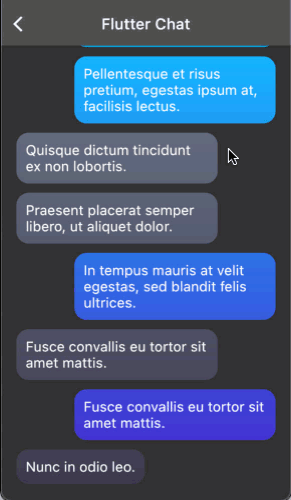Create gradient chat bubbles
Traditional chat apps display messages in chat bubbles with solid color backgrounds. Modern chat apps display chat bubbles with gradients that are based on the bubbles’ position on the screen. In this recipe, you’ll modernize the chat UI by implementing gradient backgrounds for the chat bubbles.
The following animation shows the app’s behavior:

Understand the challenge
The traditional chat bubble solution probably uses a
DecoratedBox or a similar widget to paint a rounded
rectangle behind each chat message. That approach is
great for a solid color or even for a gradient that
repeats in every chat bubble. However, modern,
full-screen, gradient bubble backgrounds require
a different approach. The full-screen gradient,
combined with bubbles scrolling up and down the screen,
requires an approach that allows you to make painting
decisions based on layout information.
Each bubble’s gradient requires knowledge of the
bubble’s location on the screen. This means that
the painting behavior requires access to layout information.
Such painting behavior isn’t possible with typical widgets
because widgets like Container and DecoratedBox
make decisions about background colors before layout occurs,
not after. In this case, because you require custom painting
behavior, but you don’t require custom layout behavior
or custom hit test behavior, a CustomPainter is
a great choice to get the job done.
Replace original background widget
Replace the widget responsible for drawing the
background with a new stateless widget called
BubbleBackground. Include a colors property to
represent the full-screen gradient that should be
applied to the bubble.
BubbleBackground(
// The colors of the gradient, which are different
// depending on which user sent this message.
colors: message.isMine
? [const Color(0xFF6C7689), const Color(0xFF3A364B)]
: [const Color(0xFF19B7FF), const Color(0xFF491CCB)],
// The content within the bubble.
child: DefaultTextStyle.merge(
style: const TextStyle(
fontSize: 18.0,
color: Colors.white,
),
child: Padding(
padding: const EdgeInsets.all(12.0),
child: child,
),
),
),
Create a custom painter
Next, introduce an implementation for BubbleBackground
as a stateless widget. For now, define the build()
method to return a CustomPaint with a CustomPainter
called BubblePainter. BubblePainter is used to paint
the bubble gradients.
@immutable
class BubbleBackground extends StatelessWidget {
const BubbleBackground({
Key? key,
required this.colors,
this.child,
}) : super(key: key);
final List<Color> colors;
final Widget? child;
@override
Widget build(BuildContext context) {
return CustomPaint(
painter: BubblePainter(
colors: colors,
),
child: child,
);
}
}
class BubblePainter extends CustomPainter {
BubblePainter({
required List<Color> colors,
}) : _colors = colors;
final List<Color> _colors;
@override
void paint(Canvas canvas, Size size) {
// TODO:
}
@override
bool shouldRepaint(BubblePainter oldDelegate) {
// TODO:
return false;
}
}
Provide access to scrolling information
The CustomPainter requires the information necessary
to determine where its bubble is within the ListView’s bounds,
also known as the Viewport. Determining the location requires
a reference to the ancestor ScrollableState
and a reference to the BubbleBackground’s
BuildContext. Provide each of those to the CustomPainter.
BubbleBackground(
scrollable: Scrollable.of(context)!,
bubbleContext: context,
// ...
),
//-----
class BubblePainter extends CustomPainter {
BubblePainter({
required ScrollableState scrollable,
required BuildContext bubbleContext,
required List<Color> colors,
}) : _scrollable = scrollable,
_bubbleContext = bubbleContext,
_colors = colors;
final ScrollableState _scrollable;
final BuildContext _bubbleContext;
final List<Color> _colors;
@override
bool shouldRepaint(BubblePainter oldDelegate) {
return oldDelegate._scrollable != _scrollable ||
oldDelegate._bubbleContext != _bubbleContext ||
oldDelegate._colors != _colors;
}
}
Paint a full-screen bubble gradient
The CustomPainter now has the desired gradient colors,
a reference to the containing ScrollableState,
and a reference to this bubble’s BuildContext.
This is all the information that the CustomPainter needs to
paint the full-screen bubble gradients.
Implement the paint() method to calculate the position
of the bubble, configure a shader with the given colors,
and then use a matrix translation to offset the shader
based on the bubble’s position within the Scrollable.
class BubblePainter extends CustomPainter {
@override
void paint(Canvas canvas, Size size) {
final scrollableBox = _scrollable.context.findRenderObject() as RenderBox;
final scrollableRect = Offset.zero & scrollableBox.size;
final bubbleBox = _bubbleContext.findRenderObject() as RenderBox;
final origin = bubbleBox.localToGlobal(Offset.zero, ancestor: scrollableBox);
final paint = Paint()
..shader = ui.Gradient.linear(
scrollableRect.topCenter,
scrollableRect.bottomCenter,
_colors,
[0.0, 1.0],
TileMode.clamp,
Matrix4.translationValues(-origin.dx, -origin.dy, 0.0).storage,
);
canvas.drawRect(Offset.zero & size, paint);
}
}
Congratulations! You now have a modern, chat bubble UI.
Recap
The fundamental challenge when painting based on the
scroll position, or the screen position in general,
is that the painting behavior must occur after the
layout phase is complete. CustomPaint is a unique
widget that allows you to execute custom painting
behaviors after the layout phase is complete.
If you execute the painting behaviors after the layout phase,
then you can base your painting decisions on the layout
information, such as the position of the CustomPaint
widget within a Scrollable or within the screen.